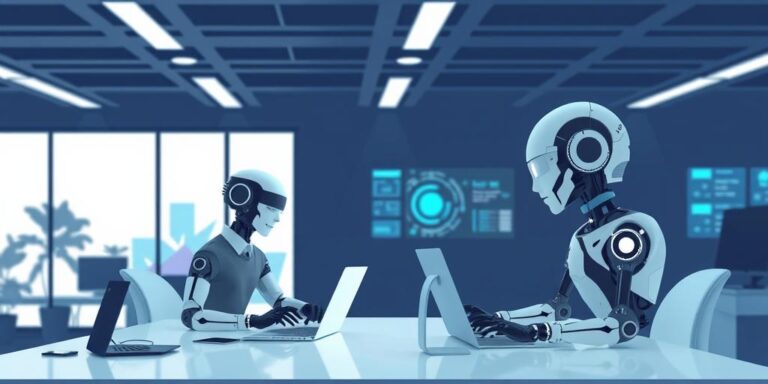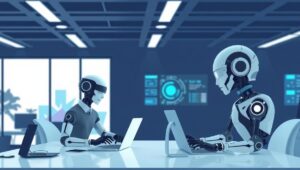The Future of Human-AI Collaboration in the Workplace (2026)
Artificial intelligence (AI) is rapidly evolving, and its integration into the workplace is no longer a futuristic concept but a present-day reality. By 2026, human-AI collaboration will be even more deeply entrenched, transforming how we work, innovate, and achieve organizational goals. This article explores the key trends, challenges, and opportunities that lie ahead in this evolving landscape.
Current State of AI in the Workplace
Today, AI is already being utilized in various capacities across industries. Chatbots handle customer service inquiries, machine learning algorithms analyze vast datasets for insights, and robotic process automation (RPA) streamlines repetitive tasks. However, these applications represent just the tip of the iceberg. As AI technology matures, its capabilities will expand, offering more sophisticated and nuanced support to human workers.
Key Trends Shaping Human-AI Collaboration by 2026
Several key trends will drive the future of human-AI collaboration:
- Enhanced AI Capabilities: AI will become more adept at understanding natural language, recognizing emotions, and adapting to dynamic situations. This will enable more seamless and intuitive interactions between humans and AI systems.
- AI-Powered Decision Support: AI will play a greater role in assisting decision-making processes. By analyzing data, identifying patterns, and generating predictions, AI can provide valuable insights to inform strategic choices.
- Personalized AI Assistants: Instead of generic AI tools, employees will have access to personalized AI assistants tailored to their specific roles and responsibilities. These assistants will learn user preferences, anticipate needs, and proactively offer support.
- AI-Driven Automation of Complex Tasks: AI will move beyond automating simple, repetitive tasks to handling more complex and creative activities. This includes tasks like content creation, product design, and even strategic planning.
- Increased Focus on Ethical AI: As AI becomes more pervasive, there will be a greater emphasis on ensuring its ethical and responsible use. Organizations will need to establish guidelines and frameworks to address issues such as bias, transparency, and accountability.
Opportunities Arising from Human-AI Collaboration
Effective human-AI collaboration presents numerous opportunities for organizations and employees alike:
- Increased Productivity: AI can automate mundane tasks, freeing up human workers to focus on higher-value activities that require creativity, critical thinking, and emotional intelligence.
- Improved Decision-Making: AI can provide data-driven insights and recommendations, enabling more informed and effective decision-making.
- Enhanced Innovation: By augmenting human capabilities, AI can foster innovation and creativity, leading to new products, services, and business models.
- Better Employee Experience: AI can personalize learning and development programs, provide real-time feedback, and offer support for employee well-being.
- Greater Customer Satisfaction: AI-powered chatbots and virtual assistants can provide personalized and efficient customer service, leading to higher levels of customer satisfaction.
Challenges to Overcome
Despite the vast potential of human-AI collaboration, several challenges must be addressed to ensure its successful implementation:
- Skills Gap: Many employees lack the skills and knowledge needed to effectively work with AI systems. Organizations will need to invest in training and development programs to bridge this gap.
- Data Privacy and Security: AI systems rely on vast amounts of data, raising concerns about data privacy and security. Organizations must implement robust safeguards to protect sensitive information.
- Job Displacement: Some fear that AI will lead to widespread job displacement. Organizations must proactively address these concerns by creating new job roles and providing retraining opportunities.
- Bias and Discrimination: AI algorithms can perpetuate and amplify existing biases if not carefully designed and monitored. Organizations must ensure that AI systems are fair and equitable.
- Lack of Trust: Some employees may be hesitant to trust AI systems or collaborate with them effectively. Organizations must build trust by demonstrating the benefits of AI and ensuring its transparency.
Preparing for the Future of Work
To thrive in the age of human-AI collaboration, organizations and individuals must take proactive steps to prepare for the future of work:
- Invest in AI Education and Training: Organizations should provide employees with opportunities to learn about AI and develop the skills needed to work with it effectively.
- Develop Ethical AI Guidelines: Organizations should establish clear guidelines and frameworks for the ethical and responsible use of AI.
- Foster a Culture of Collaboration: Organizations should encourage collaboration between humans and AI systems, emphasizing the unique strengths of each.
- Focus on Human-Centered Design: AI systems should be designed with human needs and preferences in mind, ensuring that they are user-friendly and intuitive.
- Embrace Lifelong Learning: Individuals should commit to lifelong learning, continuously updating their skills and knowledge to stay relevant in the evolving job market.
Conclusion
The future of the workplace is inextricably linked to the evolution of human-AI collaboration. By understanding the key trends, opportunities, and challenges, organizations and individuals can prepare for this transformation and harness the power of AI to create a more productive, innovative, and fulfilling work environment. As we move closer to 2026, the integration of AI will only deepen, making it imperative to embrace these changes and adapt to the new realities of the workplace.




